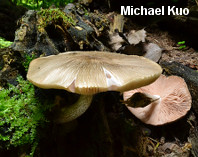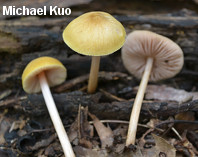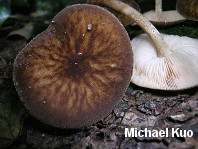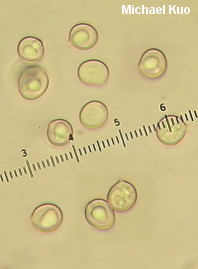Key to 41 Species of Pluteus in North America 
| 1. | Partial veil and ring absent; cap variously colored. | 2 |
| 2. | Stem bruising and discoloring bluish to greenish. | 3 |
| 3. | Found east of the Rocky Mountains; odor usually strong and unpleasant; pileipellis a cutis; pleurocystidia thick-walled. | |
| 3. | Variously distributed; odor not distinctive; pileipellis cellular; pleurocystidia thin-walled. | 4 |
| 4. | Pleurocystidia colorless; broadly lageniform to utriform; known from California to Michigan. | Pluteus cyanopus |
| 4. | Pleurocystidia brown in KOH; narrowly lageniform; known from the San Francisco Bay area. | Pluteus phaeocyanopus |
| 5. | Cap bright red to orange. | 6 |
| 5. | Cap otherwise colored. | 7 |
| 6. | Cap 2–5 cm across, bright red, fading to orange; widely distributed in North America (but more common east of the Rockies). | |
| 6. | Cap 1–1.5 cm across, scarlet when young but eventually "almost striped yellow on more orange ground" (Singer, 1956); recorded from Florida, Cuba, and Trinidad. | Pluteus laetifrons |
| 7. | Gill edges dark (brown to gray or blackish) at maturity, contrasting with the faces. | 8 |
| 7. | Gill edges not as above. | 12 |
| 8. | Mature cap 1–2 cm across; pileipellis cellular; usually on the wood of hardwoods. | Pluteus eludens
(= "P. eugraptus") |
| 8. | Mature cap more than 2 cm across; pileipellis a cutis; on wood of conifers. | 9 |
| 9. | Cap and stem finely mealy-granular or velvety; center of cap usually becoming veined. | Pluteus umbrosus |
| 9. | Cap and stem not granular or velvety; cap center not usually becoming veined. | 10 |
| 10. | Gill edges brown only from about the halfway point to the margin; prongs on pleurocystidia often branched; known from northern or northern-temperate transition regions. | Pluteus eos |
| 10. | Gill edges brown for entire length; prongs on pleurocystidia not branched; variously distributed. | 11 |
| 11. | Widely distributed in North America; most spores 7 µm long or longer; pleurocystidia with 2–5 prongs. | |
| 11. | Known from the southern Appalachians; most spores under 7 µm long; most pleurocystidia with 2 prongs. | Pluteus atrofibrillosus |
| 12. | Mature cap yellow to brownish yellow. | 13 |
| 12. | Mature cap not yellow. | 14 |
| 13. | Stem long and slender (4–10 cm x 3–6 mm); cap 3–5 cm across, often brownish to brownish yellow when young but soon brownish yellow to yellow overall, the surface finely granular; pileipellis a cutis. | |
| 13. | Stem not long and slender; cap smaller than above, bright yellow, and bald; pileipellis cellular. | |
| 14. | Cap white or whitish overall—or with a few brown fibers or scales over a white ground color. | 15 |
| 15. | Distributed from about the 45th parallel northwards; found on wood of birches and alders; mature cap not usually more than 6 cm across. | |
| 15. | Variously distributed; found on wood of various trees; cap size varying. | 16 |
| 16. | Cap 4–15 cm across; often appearing in urban areas where trees have been removed, or in woodchips (but also appearing in woods); pleurocystidia thick-walled, with apical prongs. | |
| 16. | Cap under 5 cm across—or, if larger, then also finely granular-tomentose; usually appearing in woods; pleurocystidia thin-walled, lacking prongs. | 17 |
| 17. | Cap and stem finely granular-tomentose; cap 3–6 cm across at maturity; appearing on the deadwood of conifers (rarely the wood of hardwoods) in northern and montane North America. | |
| 17. | Cap and stem not granular-tomentose; cap smaller than above; substrate and range varying. | 18 |
| 18. | Cap margin not lined; pileipellis a cutis. | Pluteus niveus |
| 18. | Cap margin lined at maturity; pileipellis cellular. | 19 |
| 19. | Pleurocystidia with long necks. | Pluteus pallidus |
| 19. | Pleurocystidia without long necks. | Pluteus roseocandidus |
| 20. | Stem yellow; pileipellis cellular. | |
| 20. | Stem not yellow; pileipellis varying. | 21 |
| 21. | Fresh cap and stem densely covered with brown granules; cap usually 3–6 cm across; pleurocystidia thin-walled; pileipellis a cutis. | |
| 21. | Cap and stem not densely covered with brown granules; cap size varying; pleurocystidia varying; pileipellis varying. | 22 |
| 22. | Cap medium sized to large (regularly 4–5 cm wide or more at maturity); mushroom belonging in "Section Machopluteus." | 23 |
| 22. | Cap smaller than above; mushroom belonging in "Section Wimpopluteus." | 36 |
| 23. | Growing on woodchips, or on stumps of recently cut hardwood trees in urban areas; fusiform intermediate cystidia (illustration) usually abundant. | |
| 23. | Growing in woods; fusiform intermediate cystidia present or absent. | 24 |
| 24. | Usually found on wood of conifers. | 25 |
| 24. | Usually found on wood of hardwoods. | 30 |
| 25. | Found in western North America. | 26 |
| 25. | Found east of the Rocky Mountains. | 28 |
| 26. | Clamp connections absent from pileipellis. | Pluteus exilis |
| 26. | Clamp connections present in pileipellis. | 27 |
| 27. | Cap usually pale gray, rarely brown; montane (known from the Cascades and the Sierra Nevada); pleurocystidia with inconspicuous prongs. | Pluteus orestes |
| 27. | Cap usually brown; not montane (known from coastal California); pleurocystidia with well-developed prongs. | Pluteus primus |
| 28. | Cheilocystidia long (55–120+ µm) and usually cylindric to slightly swollen. | Pluteus primus |
| 28. | Cheilocystidia 30–70 µm, club-shaped to sphere-shaped. | 29 |
| 29. | Spores measuring up to 7.5 µm long and 5 µm wide. | Pluteus hibbettii |
| 29. | Spores measuring up to 9 µm long and 6 µm wide. | Pluteus methvenii |
| 30. | Clamp connections present in pileipellis. | Pluteus brunneidiscus |
| 30. | Clamp connections absent in pileipellis. | 31 |
| 31. | Fusiform intermediate cystidia (illustration) usually abundant. | 32 |
| 31. | Intermediate cystidia variously shaped but not predominantly fusiform. | 33 |
| 32. | Widely distributed; found in urban settings, including woodchips, and in woods; spores 3.5–5.5 µm wide. | |
| 32. | Probably limited to boreal and northern transitional forests; spores 4.5–6.5 µm wide. | Pluteus rangifer |
| 33. | Known from the West Coast, in coastal forests from Santa Cruz County, CA to British Columbia; cap usually dark brown; stem usually scaly. | Pluteus exilis |
| 33. | Known from eastern North America; cap brown to dark brown; stem scaly or not. | 34 |
| 34. | Prongs on pleurocystidia not generally branched or bifurcated. | |
| 34. | Prongs on pleurocystidia mostly branched or bifurcated. | 35 |
| 35. | Stem featuring conspicuous brown fibrils; northern and montane species. | Pluteus elaphinus |
| 35. | Stem lacking conspicuous brown fibrils; temperate species. | Pluteus hongoi |
| 36. | Pileipellis cellular, or cellular with filamentous to cystidioid elements mixed in. | 37 |
| 36. | Pileipellis a cutis with no cellular elements. | 41 |
| 37. | Pileipellis composed of both filamentous to cystidioid elements and cellular elements. | 38 |
| 37. | Pileipellis composed of only cellular elements. | 39 |
| 38. | Cap often (but not always) developing ridges in a reticulate pattern; cystidia (especially cheilocystidia) with short to long, fingerlike apical projections. | |
| 38. | Cap not usually becoming ridged and reticulate; cystidia without apical projections. | Pluteus seticeps |
| 39. | Tropical to subtropical species; spores mostly globose to subglobose; hymenial cystidia mostly subutriform. | Pluteus jamaicensis |
| 39. | Temperate species; spores mostly broadly ellipsoid to subglobose; hymenial cystidia varying. | 40 |
| 40. | Cap soon notably "rimose" (cracked radially); pileipellis elements variable in size, with frequent large elements (exceeding 40 x 60 µm); pleurocystidia utriform to widely cylindric. | |
| 40. | Cap not normally rimose; pileipellis elements smaller; pleurocystidia narrowly lageniform, with long necks. | Pluteus phlebophorus |
| 41. | Usually found on the wood of conifers. | 42 |
| 41. | Usually found on the wood of hardwoods. | 45 |
| 42. | Pleurocystidia with walls under 2 µm thick, without prongs, or with inconspicuous prongs. | 43 |
| 42. | Pleurocystidia with conspicuous prongs and walls 2 µm thick or more. | 44 |
| 43. | Spores 7.5–9 µm long; cheilocystidia cylindric, narrowly clavate, or narrowly lageniform. | Pluteus oreibatus |
| 43. | Spores 6–7.5 µm long; cheilocystidia widely lageniform to subutriform. | Pluteus fuliginosus |
| 44. | Spores averaging 7–7.5 x 4.5–7 µm. | Pluteus hibbettii |
| 44. | Spores averaging 7–9 x 5–6 µm. | Pluteus methvenii |
| 45. | Pleurocystidia with thin walls, lacking prongs; cap becoming conspicuously grooved from the margin nearly to the center. | |
| 45. | Pleurocystidia with thick walls and prongs; cap not usually conspicuously grooved. | 46 |
| 46. | Clamp connections present in pileipellis. | 47 |
| 46. | Clamp connections absent from pileipellis. | 48 |
| 47. | Pleurocystidia with walls under 2 µm thick, lacking prongs, or with inconspicuous prongs; known (so far) from Illinois. | Pluteus saupei |
| 47. | Pleurocystidia with walls often greater than 2 µm thick, with conspicuous prongs; widespread in North America. | Pluteus brunneidiscus |
| 48. | Stem with conspicuous brown fibrils or small scales; boreal and boreal-temperate transitional species. | Pluteus elaphinus |
| 48. | Stem lacking brown fibrils; tropical and subtropical species. | Pluteus harrisii |
References
Banerjee, P. & W. J. Sundberg (1995). The genus Pluteus section Pluteus (Pluteaceae, Agaricales) in the Midwestern United States. Mycotaxon 53: 189-246.
Homola, R. L. (1972). Section Celluloderma of the genus Pluteus in North America. Mycologia 64: 1211-1247.
Justo, A. & M. L. Castro (2007). Pluteus nothopellitus sp. nov. and a review of white species in Pluteus section Pluteus. Mycotaxon 102: 221–230.
Justo, A., A. M. Minnis, S. Ghignone, N. Menolli Jr., M. Capelari, O. Rodriguez, E. Malysheva, M. Contu & A. Vizzini (2011a). Species recognition in Pluteus and Volvopluteus (Pluteaceae, Agaricales): morphology, geography and phylogeny. Mycological Progress 10: 453-479.
Justo, A., A. Vizzini, A. M. Minnis, N. Menolli Jr., M. Capelari, O. Rodriguez, E. Malysheva, M. Contu, S. Ghignone & D. S. Hibbett (2011b). Phylogeny of the Pluteaceae (Agaricales, Basidiomycota): taxonomy and character evolution. Fungal Biology 115: 1-20.
Justo, A., A. Caballero, G. Munoz, A. M. Minnis & E. Malyesheva (2011c). Taxonomy of Pluteus eugraptus and morphologically similar taxa. Mycologia 103: 646-655.
Justo, A., E. Malysheva, T. Bulyonkova, E. C. Vellinga, G. Cobian, N. Nguyen, A. M. Minnis & D. S. Hibbett (2014). Molecular phylogeny and phylogeography of Holarctic species of Pluteus section Pluteus (Agaricales: Pluteaceae), with description of twelve new species. Phytotaxa 180: 1-85.
Kibby, G., A. Burnham & A. Henrici (2010). Some problems in the genus Pluteus. Field Mycology 11: 93–100.
Minnis, A. M., W. J. Sundberg, A. S. Methven, S. D. Sipes & D. L. Nickrent (2006). Annulate Pluteus species, a study of the genus Chamaeota in the United States. Mycotaxon 96: 31-39.
Minnis, A. M. & W. J. Sundberg (2010). Pluteus section Celluloderma in the U. S. A. North American Fungi 5: 1-107.
Singer, R. (1956). Contributions towards a monograph of the genus Pluteus. Transactions of the British Mycological Society 39: 145-232.
Singer, R. (1978). Keys for the identification of the species of Agaricales II. Sydowia 31: 193-237.
Smith, A. H. & D. E. Stuntz (1958). Studies on the genus Pluteus I. Redescriptions of American species based on a study of type specimens. Lloydia 21: 115-136.
Vellinga, E. C. & J. Schreurs (1985). Notulae ad floram agaricinam neerlandlicam - VIII. Pluteus Fr. In West-Europe. Persoonia 12: 337-373.
Vellinga, E. C. (1990). Pluteus. In Bas, C., Th. W. Kuyper, M. E. Noordeloos & E. C. Vellinga (1990). Flora Agaricina Neerlandica: Critical monographs on families of agarics and boleti occurring in the Netherlands. Volume 2. Rotterdam: A. A. Balkema. 31-55.
Cite this page as:
Kuo, M. (2015, July). The genus Pluteus. Retrieved from the MushroomExpert.Com Web site: http://www.mushroomexpert.com/pluteus.html
© MushroomExpert.Com





